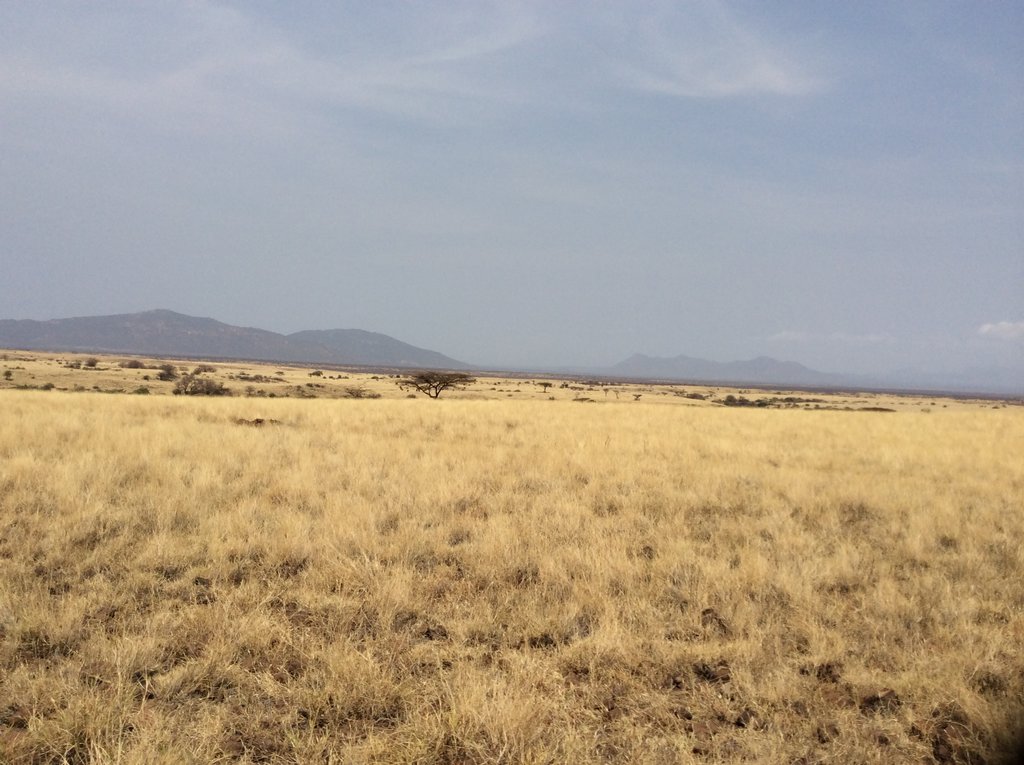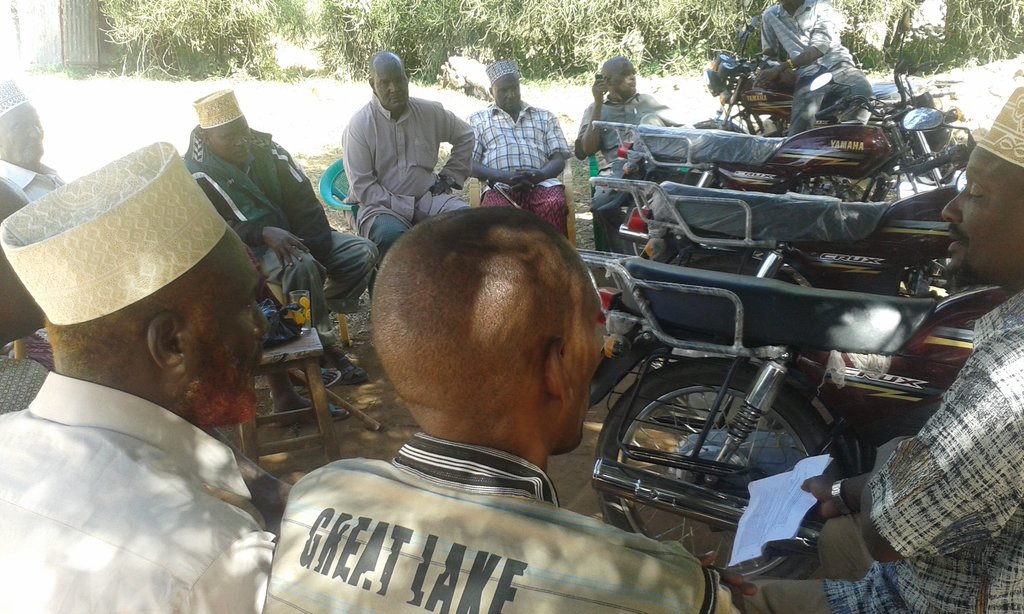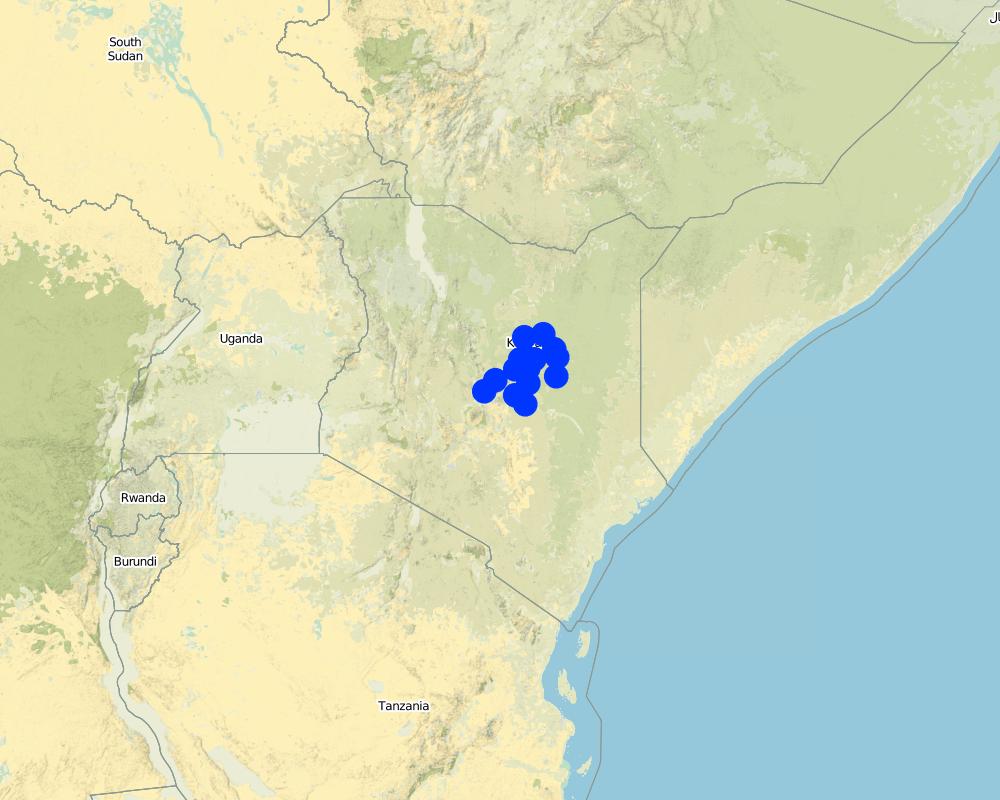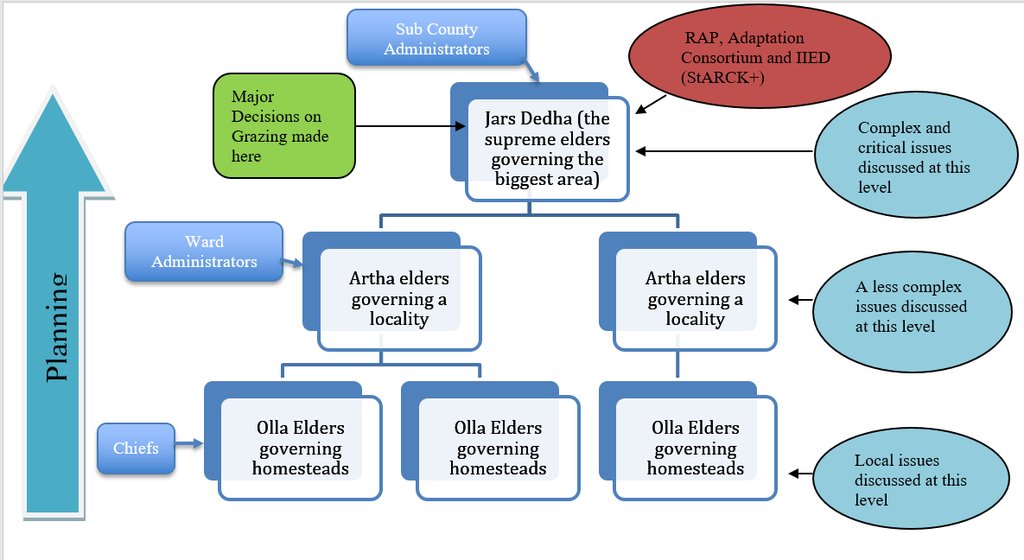Empowering Dedha institutions in governing the natural resources of Isiolo rangelands [Kenya]
- Création :
- Mise à jour :
- Compilateur : IBRAHIM JARSO
- Rédacteur : Caroline King-Okumu
- Examinateur : Rima Mekdaschi Studer
Jars Dedha
approaches_3345 - Kenya
- Résumé complet en PDF
- Résumé complet en PDF pour impression
- Résumé complet dans le navigateur
- Résumé complet (non formaté)
- Empowering Dedha institutions in governing the natural resources of Isiolo rangelands: 13 mai 2018 (inactive)
- Empowering Dedha institutions in governing the natural resources of Isiolo rangelands: 31 juillet 2018 (inactive)
- Empowering Dedha institutions in governing the natural resources of Isiolo rangelands: 3 septembre 2018 (inactive)
- Empowering Dedha institutions in governing the natural resources of Isiolo rangelands: 2 novembre 2021 (public)
Voir les sections
Développer tout Réduire tout1. Informations générales
1.2 Coordonnées des personnes-ressources et des institutions impliquées dans l'évaluation et la documentation de l'Approche
exploitant des terres:
Boru Edin
+254 715 627 545
Kinna Dedha Elders
Kinna town, Kinna Ward, Isiolo County.
Kenya
Non-State Actor:
Jama Abdiaziz
+254 707 720 577
aziz2012ke@gmail.com
Pastoralist Capacity Development Programme (PACDEP)
Isiolo Town, Kenya
Kenya
exploitant des terres:
Diba Rukia
+254 728 643 044
Ward Adaptation Planning Committee
Kinna, Isiolo County
Kenya
Spécialiste GDT:
Nom du projet qui a facilité la documentation/ l'évaluation de l'Approche (si pertinent)
Strengthening Adaptation and Resilience to Climate Change in Kenya Plus (StARCK+)Nom du ou des institutions qui ont facilité la documentation/ l'évaluation de l'Approche (si pertinent)
Resource Advocacy Programme (RAP) - Kenya1.3 Conditions relatives à l'utilisation par WOCAT des données documentées
Quand les données ont-elles été compilées (sur le terrain)?
03/11/2017
Le compilateur et la(les) personne(s) ressource(s) acceptent les conditions relatives à l'utilisation par WOCAT des données documentées:
Oui
1.4 Références au(x) questionnaire(s) sur les Technologies de GDT
2. Description de l'Approche de GDT
2.1 Courte description de l'Approche
This approach – driven by communities and supported by various agencies - aims to revive and strengthen the traditional natural resource management institutions of Boran pastoralists in Northern Kenya. The traditional system, which was devised by the Boran pastoral community and honed over centuries to suit the challenges of the rangelands, has been steadily eroded by external factors and formalised systems after the emergence of the nation-state.
2.2 Description détaillée de l'Approche
Description détaillée de l'Approche:
Pastoral Community Members together with the Jarsa Dedha (the council of elders who control the use of grazing land and its resources) are at the forefront of reinvigorating traditions of rangeland management. To achieve this, they have been supported by organizations including the Ward Adaptation Planning Committees (WAPC), the Resource Advocacy Programme (RAP) and the International Institute for Environment and Development (IIED). There has been a focus on reviving traditional institutions and systems of managing of natural resources to help communities adapt to climate change.
One specific project that has assisted the re-empowerment of the Dedha institutions was StARCK+ (funded by DfID). StARCK+ was founded on an understanding and an appreciation of the traditional natural resource governance of the Boran pastoral community. Responding to participatory demand it undertook to help strengthen this customary natural resource management system. Various agencies have also conducted research on the traditional institution and investigated how it could be improved. These include IIED, (UK), the University of Nairobi, (Kenya) and the University of Sussex (UK).
The Jarsa Dedha is an indigenous institution, through which customary laws and provisions guide the management of natural resources. The Boran of Isiolo County, Kenya, like their kin in southern Ethiopia, derive their customary laws from an overall supreme general assembly called the Gadha. The Gadha governing council preserves traditional laws and codes of conduct, as well as issuing amendments and additions based on the evolving environmental, social and cultural context. The Gadha system has a set of laws and provisions (seere), customs and culture (aada), and norms and values that govern society.
The recognition and observance of seere and aada are still considered vital for the wellbeing of the community, and the Gadha Council remains a legitimate institution in the eyes of Borana society. However, adherence to these laws is declining and the power of Borana customary institutions to enforce regulations is being undermined in a number of ways.
The reasons for weakening traditional institutions are basically poor recognition by the county and national government, and non-compliance with the rules due to changing socio-cultural norms. The council of elders that govern grazing resources, the Jarsa Dedha, which is the custodian of these unwritten rules and regulations locally, no longer has sufficient capacity or authority to enforce them as it had done prior to colonial rule. With climate change, pasture and water supplies are becoming scarcer and there is no other better way to govern land than the traditional system: that is why reviving, strengthening and improving the system was much welcomed through the advent of the StARCK+ project and the initiatives and support that have followed.
Looking towards the future, the rules of governing natural resources have been collected and formed into a draft county customary natural resource governance bill. This, if passed by the County Assembly, would represent a very significant step, by legitimising the traditional system of rangeland management through the Jarsa Dedha.
2.3 Photos de l'approche
2.4 Vidéos de l'Approche
Commentaire, brève description:
The video clearly defines the technology and the approach
Date:
20/02/2015
Lieu:
Garbatulla Area
Nom du vidéaste:
Hilda Kathure
2.5 Pays/ région/ lieux où l'Approche a été appliquée
Pays:
Kenya
Région/ Etat/ Province:
Isiolo
Autres spécifications du lieu :
Pastoral areas of Isiolo
Map
×2.6 Dates de début et de fin de l'Approche
Indiquez l'année de démarrage:
2012
Si l'année précise est inconnue, indiquez approximativement quand l'Approche a démarré:
il y a moins de 10 ans (récemment)
Commentaires:
The project started 2012 and ended 2016 but the approach is still continuing
2.7 Type d'Approche
- traditionnel/ autochtone
2.8 Principaux objectifs de l'Approche
The Approach is aimed at strenghthening and re-empowering the traditional institutions that govern rangeland management in the rangelands of Isiolo, in order to improve utilisation of natural resources and build community resilience to droughts and future environmental changes.
2.9 Conditions favorisant ou entravant la mise en œuvre de la(des) Technologie(s) appliquée(s) sous l'Approche
normes et valeurs sociales/ culturelles/ religieuses
- favorise
The approach was traditional and embedded in the culture of boran pastoralists and therefore easy to implement.
- entrave
The commercialization of livestock and its production like milk has made it difficult for elders to implement the approach.
disponibilité/ accès aux ressources et services financiers
- favorise
Communities make their own contributions to support implementation of the approach.
- entrave
No specific budget assigned by government authority for this approach: some funds from projects and county government and contributions from the pastoralists themselves.
cadre institutionnel
- favorise
Well elaborated organizational design at all levels of institutional scale.
- entrave
Collision between the mandates of traditional structure and formal structure. This was addressed through accepting Chiefs as ex-official members in the Dedha council of elders.
collaboration/ coordination des acteurs
- favorise
Many NGOs and local organization support the implementation of the approach through providing means for surveillance such as vehicles or motorbikes. NGOs frequently also support Dedha assemblies that involve meetings of people from far away.
- entrave
Government and some NGOs sometimes establish parallel grazing committees.
cadre juridique (régime foncier, droits d'utilisation des terres et de l'eau)
- favorise
Traditional tenure system.
- entrave
No legal papers for the ownership.
cadre politique
- favorise
Traditional provisions and rules known by all community members.
- entrave
Traditional rules not known to everyone.
gouvernance foncière (prise de décisions, mise en œuvre et application des décisions)
- favorise
Elders make key decisions on governance of land.
- entrave
Women and youth not well involved in decision making although changes are happening nowadays to include them.
connaissances sur la GDT, accès aux supports techniques
- favorise
Traditional skills much used.
- entrave
Little technical support.
marchés (pour acheter les intrants, vendre les produits) et prix
- favorise
Ensures security and market thrives.
- entrave
The approach is more social and not market oriented.
charge de travail, disponibilité de la main-d'œuvre
- favorise
Youth provide man power Voluntarily.
- entrave
Volunteers sometimes don’t come out for work.
3. Participation et rôles des parties prenantes impliquées dans l'Approche
3.1 Parties prenantes impliquées dans l'Approche et rôles
- exploitants locaux des terres / communautés locales
Boran Community members, Dedha elders.
Agree on the pasture and water management approach and implement .
- organisations communautaires
Ward Adaptation Planning Committees.
Implement community plans and fundraise for it.
- ONG
Resource Advocacy Programme (RAP), Merti Integrated Development Programme (MIDP), Pastoralist A Capacity Development E Programme (PACDEP), International Institute for Environment Development and Adaptation Consortium (ADA)
Support communities in implementing the approach.
Ward Adaptation Planning Committees; Implement community plans and fundraise for it.
Si plusieurs parties prenantes sont impliquées, indiquez l'organisme chef de file ou l'institution responsable:
WAPC , ADA and IIED
3.2 Participation des exploitants locaux des terres/ communautés locales aux différentes phases de l'Approche
| Participation des exploitants locaux des terres/ communautés locales | Spécifiez qui était impliqué et décrivez les activités | |
|---|---|---|
| initiation/ motivation | interactive | Pastoral Community Members, Dedha elders and supporting organizations like WAPC, RAP, IIED and DfID supported the process of reviving the traditional system of management of natural resources to help communities adapt to climate change. |
| planification | interactive | Pastoral Community Members and Dedha Elders to improve their systems of management of land and land-based resources. |
| mise en œuvre | interactive | Dedha elders as they are tasked with ensuring that the natural resource governance system is successful. |
| suivi/ évaluation | interactive | Pastoralists and elders to keep those tasked are properly undertaking the responsibilities. |
3.3 Diagramme/ organigramme (si disponible)
Description:
The Dedha traditional system of managing resources has internal hierarchy at different levels i.e. Olla (homestead), Artha (locality) and Dedha (a large area). Although planning and minor decisions are made at local levels, major and binding decisions are agreed at Dedha level on grazing and management of pasture. Many NGOs and government actors engage the management system at Dedha level.
Auteur:
Ibrahim Jarso
3.4 Prises de décision pour la sélection de la Technologie/ des Technologies
Indiquez qui a décidé de la sélection de la Technologie/ des Technologies à mettre en œuvre:
- tous les acteurs concernés dans le cadre d'une approche participative
Expliquez:
The Participatory process is very essential in making the governance system work for pastoralists.
Spécifiez sur quelle base ont été prises les décisions:
- expériences et opinions personnelles (non documentées)
4. Soutien technique, renforcement des capacités et gestion des connaissances
4.1 Renforcement des capacités/ formation
Une formation a-t-elle été dispensée aux exploitants des terres/ autres parties prenantes?
Oui
Spécifiez qui a été formé:
- exploitants des terres
Si pertinent, spécifiez le genre, l'âge, le statut, l'ethnie, etc.
Largely elders but women and youth are also represented in the training.
Formats de la formation:
- sur le tas
- entre agriculteurs (d'exploitants à exploitants)
- réunions publiques
Thèmes abordés:
Constitutional clauses supporting management of land through traditional institutions.
Need to legislate the local traditional rules to county laws. Participatory mapping of Natural Resources in the grazing areas to improve planning.
Commentaires:
Community members really participated in the processes and trainings and understood the contemporary issues.
4.2 Service de conseils
Les exploitants des terres ont-ils accès à un service de conseils?
Oui
Spécifiez si le service de conseils est fourni:
- dans des centres permanents
Décrivez/ commentez:
The pastoralist extension training sessions take place in Agricultural Training Centre in Isiolo Town. They are normally conducted once or twice a year because of financial constraints.
4.3 Renforcement des institutions (développement organisationnel)
Des institutions ont elles été mises en place ou renforcées par le biais de l'Approche?
- oui, beaucoup
Spécifiez à quel(s) niveau(x), ces institutions ont été renforcées ou mises en place:
- local
Décrivez l'institution, ses rôles et responsabilités, ses membres, etc.
The Dedha institution has been strengthened as they were enabled to undertake their responsibilities better.
Précisez le type de soutien:
- équipement
- Their meetings were supported and made frequent and increased reach.
Donnez plus de détails:
Provided with materials like motorbikes.
4.4 Suivi et évaluation
Le suivi et l'évaluation font ils partie de l'Approche? :
Oui
Commentaires:
This is a traditional approach and it is effectively self-monitored for learning and improvement.
Si oui, ce document est-il destiné à être utilisé pour le suivi et l'évaluation?
Oui
4.5 Recherche
La recherche a-t-elle fait partie intégrante de l’Approche?
Oui
Spécifiez les thèmes:
- sociologie
- économie/ marketing
- écologie
- technologie
Donnez plus de détails et indiquez qui a mené ces recherches:
Various institutions have conducted research on the traditional institution and investigated how it could be improved through strengthening and reviving it with new initiatives for improved governance of natural resources. The institutions are the International Institute for Environment and Development, (UK), the University of Nairobi, (Kenya) and the University of Sussex (UK).
5. Financement et soutien matériel externe
5.1 Budget annuel de la composante GDT de l'Approche
Commentez (par ex. principales sources de financement/ principaux bailleurs de fonds):
The traditional system is self sustaining and thrives through local contributions but no specific budget lines.
5.2 Soutiens financiers/ matériels fournis aux exploitants des terres
Les exploitants des terres ont-ils reçu un soutien financier/ matériel pour la mise en œuvre de la Technologie/ des Technologies?
Non
5.3 Subventions pour des intrants spécifiques (incluant la main d'œuvre)
- aucun
Si la main d'œuvre fournie par les exploitants des terres était un intrant substantiel, elle était:
- volontaire
Commentaires:
The land users are pastoralists and surveillance of grazing reserves were undertaken to protect their pastures from irregular access. Dedha elders oversee the surveillance and health of rangelands.
5.4 Crédits
Des crédits ont-ils été alloués à travers l'Approche pour les activités de GDT?
Non
5.5 Autres incitations ou instruments
D'autres incitations ou instruments ont-ils été utilisés pour promouvoir la mise en œuvre des Technologies de GDT?
Oui
Si oui, spécifiez:
The rules of governing natural resources were collected and documented into a county customary natural resource governance bill.
6. Analyses d'impact et conclusions
6.1 Impacts de l'Approche
Est-ce que l'Approche a autonomisé les exploitants locaux des terres, amélioré la participation des parties prenantes?
- Non
- Oui, un peu
- Oui, modérément
- Oui, beaucoup
Strengthens community rights and ownership of their land.
Est-ce que l'Approche a permis la prise de décisions fondées sur des données probantes?
- Non
- Oui, un peu
- Oui, modérément
- Oui, beaucoup
The Approach convened the community and identified the community challenges and worked on it with the support of Dedha elders.
Est-ce que l'Approche a aidé les exploitants des terres à mettre en œuvre et entretenir les Technologies de GDT?
- Non
- Oui, un peu
- Oui, modérément
- Oui, beaucoup
Supported the essential activities of the traditional system and made it easy to implement.
Est-ce que l'Approche a amélioré la coordination et la mise en œuvre de la GDT selon un bon rapport coût-efficacité?
- Non
- Oui, un peu
- Oui, modérément
- Oui, beaucoup
Improved coordination among the partners and made implementation easy.
Beside getting support from County climate adaptation program through the Ward Adaptation Planning Committee, the approach also got support from Water Sector Trust Fund.
Est-ce que l'Approche a amélioré les connaissances et les capacités des exploitants des terres pour mettre en œuvre la GDT?
- Non
- Oui, un peu
- Oui, modérément
- Oui, beaucoup
The knowledge is culturally passed to generations
Est-ce que l'Approche a amélioré les connaissances et les capacités des autres parties prenantes?
- Non
- Oui, un peu
- Oui, modérément
- Oui, beaucoup
Yes, other stakeholders’ knowledge on the system was also improved.
Est-ce que l'Approche a construit/ renforcé les institutions, la collaboration entre parties prenantes?
- Non
- Oui, un peu
- Oui, modérément
- Oui, beaucoup
Yes, the Approach made local indigenous institution stronger and enhanced their collaboration.
Est-ce que l'Approche a atténué les conflits?
- Non
- Oui, un peu
- Oui, modérément
- Oui, beaucoup
It provided platform for resource based conflict discussions and also settled many of local and trans-boundary conflicts through the empowered Dedha elders
Est-ce que l'Approche a autonomisé les groupes socialement et économiquement défavorisés?
- Non
- Oui, un peu
- Oui, modérément
- Oui, beaucoup
Yes, the approached saved livestock from death in times of drought and built pastoral communities economically.
Est-ce que l'Approche a amélioré l'égalité entre hommes et femmes et autonomisé les femmes et les filles?
- Non
- Oui, un peu
- Oui, modérément
- Oui, beaucoup
The aAproach engaged the Dedha elders to accept women in their traditional institutions and entrenched gender in establishment of WAPCs
Est-ce que l'Approche a encouragé les jeunes/ la prochaine génération d'exploitants des terres à s'engager dans la GDT?
- Non
- Oui, un peu
- Oui, modérément
- Oui, beaucoup
Many youth were involved in implementing the Traditional systems of governance as a result of the approach
Est-ce que l'Approche a amélioré les questions foncières et des droits d'utilisation qui entravent la mise en œuvre des Technologies?
- Non
- Oui, un peu
- Oui, modérément
- Oui, beaucoup
Yes, the Approach led to formulation of customary natural resource management bill meant to enhance land rights.
Est-ce que l'Approche a conduit à améliorer la sécurité alimentaire et/ou la nutrition?
- Non
- Oui, un peu
- Oui, modérément
- Oui, beaucoup
Yes, through ensuring retention of livestock asset.
Est-ce que l'Approche a amélioré l'accès aux marchés?
- Non
- Oui, un peu
- Oui, modérément
- Oui, beaucoup
The Approach through improvement of range management institution of Dedha, has helped to ensure there is food for pastoral herds and livestock with good body conditions were sold in local markets in good prices
Est-ce que l'Approche a conduit à améliorer l'accès à l'eau et l'assainissement?
- Non
- Oui, un peu
- Oui, modérément
- Oui, beaucoup
Yes, through the approach many water facilities were better managed.
Est-ce que l'Approche a amélioré la capacité des exploitants des terres à s'adapter aux changements/ extrêmes climatiques et a atténué les catastrophes liées au climat?
- Non
- Oui, un peu
- Oui, modérément
- Oui, beaucoup
Yes, the Approach empowered the community to arrange their pattern of grazing to wet, dry season and grazing reserves to cope with climate extremes and disasters.
Est-ce que l'Approche a conduit à des emplois, des opportunités de revenus?
- Non
- Oui, un peu
- Oui, modérément
- Oui, beaucoup
Yes, many job opportunities were created for locals and also private businesses.
6.2 Principale motivation des exploitants des terres pour mettre en œuvre la GDT
- augmenter la production
The livestock was calving and reproducing very fast leading to increased production as a result of good management of land.
- augmenter la rentabilité/ bénéfice, rapport coûts-bénéfices
With minimal and voluntary inputs the pastoralists keep livestock in the range and make a lot of profit when they sell.
- réduire la dégradation des terres
The controlled grazing pattern led to regeneration of degraded rangelands and improved its ecosystem services.
- réduire les risques de catastrophe
With strengthened dedha elders the community were able to prepare very well to drought and other disasters.
- réduire la charge de travail
Available pasture when needed reduced the challenges of mobility to far areas and excess workload.
- prestige, pression sociale/ cohésion sociale
The approach enhances local prestige and also reduces the incidences of conflict in tough times enhancing social cohesion.
- conscience environnementale
The approach allows regeneration of natural vegetation as pastoralists preserve pasture in one grazing area as they grazing in the other.
- coutumes et croyances, morale
The approach uses traditional etiquettes which enhances customs and beliefs.
- améliorer les connaissances et compétences en GDT
The approach allows young people to learn and attain new knowledge on proper governance of natural resources as well the elders attain new contemporary skills to manage land.
- améliorer l'esthétique
The preserved grazing areas allows pasture to blossom and very beautiful to the eye as ecosystems regenerates and gets in to new life.
- atténuer les conflits
The approach reduces incidences of conflict as the use and stewardship of pasture and water is clearly defined.
6.3 Durabilité des activités de l'Approche
Les exploitants des terres peuvent-ils poursuivre ce qui a été mis en œuvre par le biais de l'Approche (sans soutien extérieur)?
- oui
Si oui, décrivez de quelle manière:
The traditional system of managing natural resources for pastoralists has been in place for time immemorial and it supports their way of life and even if there is minimal support from outside, such as the empowering approach, the SLM will still continue as it was developed by Boran pastoralists – who feel it is the most legitimate and appropriate system of governing rangelands in the region. This has been confirmed by many analytical studies of the system.
6.4 Points forts/ avantages de l'Approche
| Points forts/ avantages/ possibilités du point de vue de l'exploitant des terres |
|---|
| It is inherent approach that will pass to the next generation of pastoralists with the new innovations that are incorporated over the years. |
| It is the cheapest and easiest way of managing the rangelands for posterity. |
| It is a very flexible approach that's accepting new changes so that the technology is conversant at all times. |
| Points forts/ avantages/ possibilités du point de vue du compilateur ou d'une autre personne ressource clé |
|---|
| It is a legitimate system recognized by all pastoralist for management of their rangeland resources. |
| It is conservative and less costly to implement in the vast rangelands with little incentives. |
6.5 Faiblesses/ inconvénients de l'Approche et moyens de les surmonter
| Faiblesses/ inconvénients/ risques du point de vue de l’exploitant des terres | Comment peuvent-ils être surmontés? |
|---|---|
| There is no law protecting it. | The government need to establish a law that recognizes and protects the approach. |
| The changing social norms with globalization and diversification of livelihood is pausing a challenge like Commercial Pastoralism | Government need to establish policies and plans as well as legislations that recognizes the traditional systems and institution for the approach to be successful for long |
| Faiblesses/ inconvénients/ risques du point de vue du compilateur ou d'une autre personne ressource clé | Comment peuvent-ils être surmontés? |
|---|---|
| There are many competing claims over rangeland resources and government supports some. | Create awareness of local leaders about the competing claims and lobby them to protect rangeland resources. |
7. Références et liens
7.1 Méthodes/ sources d'information
- visites de terrain, enquêtes sur le terrain
2 visits
- interviews/entretiens avec les exploitants des terres
6 interviews
- compilation à partir de rapports et d'autres documents existants
2
7.2 Références des publications disponibles
Titre, auteur, année, ISBN:
Evolving pastoralists institutions by patison and tari
Disponible à partir d'où? Coût?
IIED Website
7.3 Liens vers les informations pertinentes disponibles en ligne
Titre/ description:
Evolving customary institutions by patison and tari
URL:
pubs.iied.org/pdfs/10076IIED.pdf
Titre/ description:
Strengthening Customary institutions the case of Isiolo County Northern Kenya by Caroline, Tari and Jarso
URL:
www.celep.info/wp-content/uploads/2015/11/Strengthening-local-institutions.pdf
Titre/ description:
Investing in institutional ‘software’ to build climate resilience
URL:
https://anglejournal.com/article/2015-06-investing-in-institutional-software-to-build-climate-resilience/
Titre/ description:
Inclusive green growth in Kenya: Opportunities in the dryland water and rangeland sectors
URL:
http://pubs.iied.org/10137IIED/
Titre/ description:
Vegetation resources and their economic importance in Isiolo County, Kenya
URL:
http://pubs.iied.org/10141IIED/
Liens et modules
Développer tout Réduire toutLiens
Aucun lien
Modules
Aucun module trouvé







